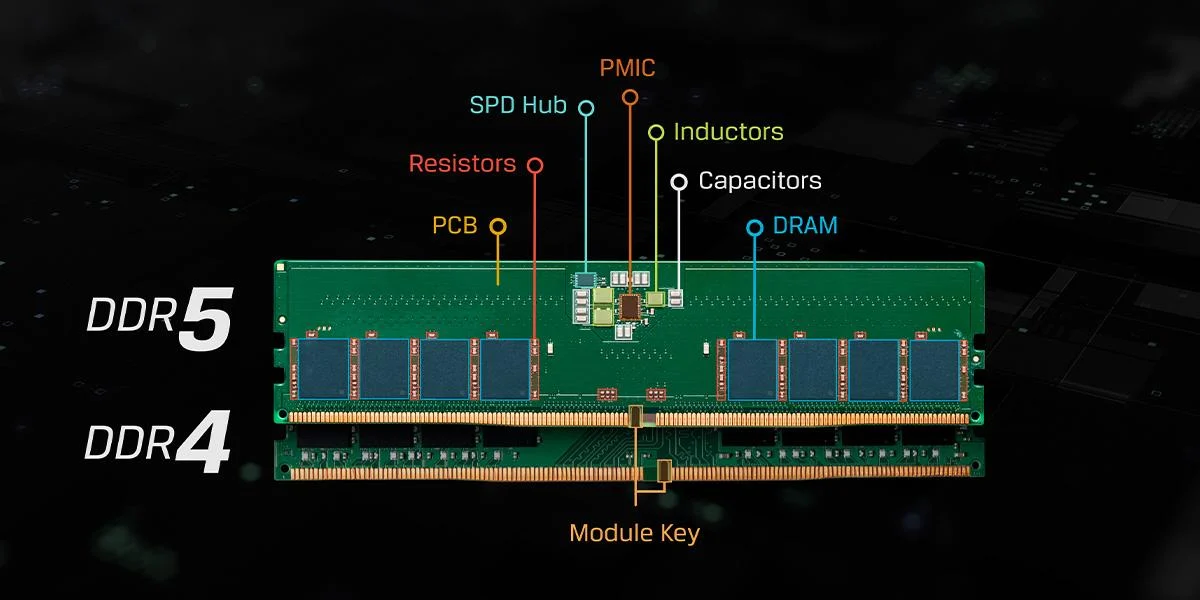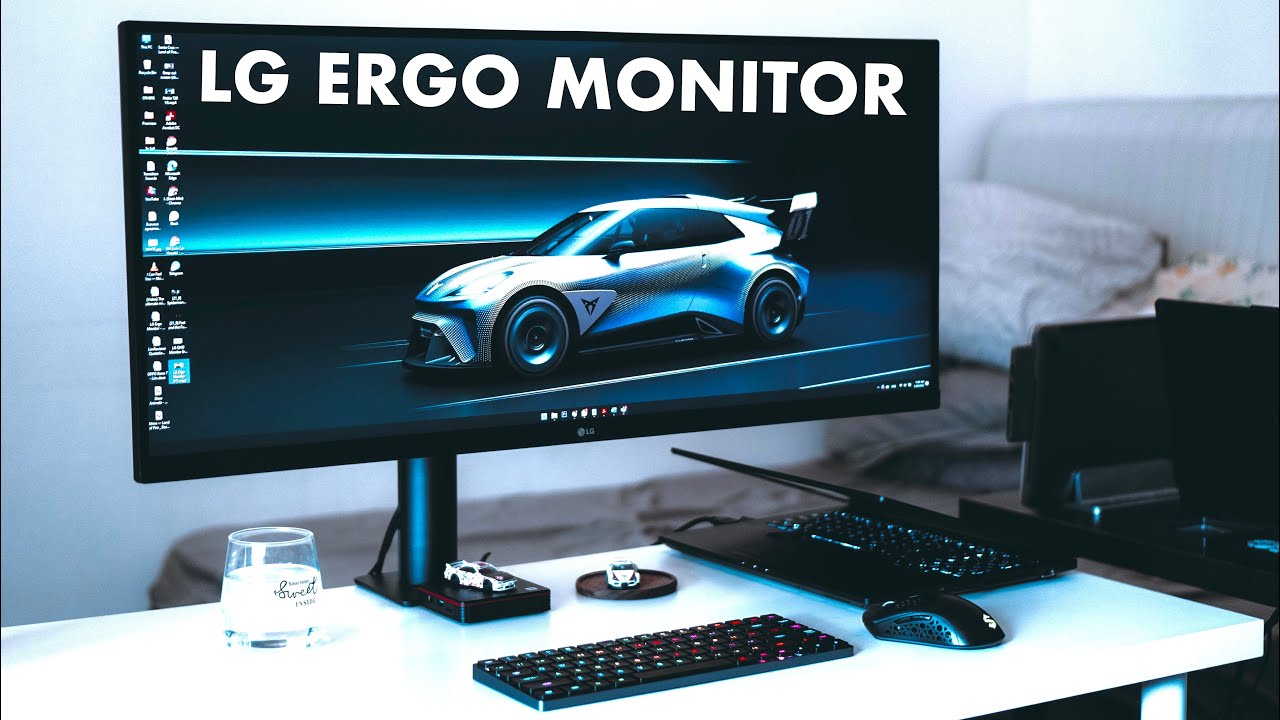
hey guys snows here from hardware canucks and this is a beginner’s guide to ddr5 an intro course of sorts to the newest and what should be the greatest leap in memory technology in a while we’re going to talk about some of the differences between ddr4 and ddr5 what you need to know about building a new system with this new memory type and of course some really interesting performance differences between the two honestly there are some myths that i’m gonna bust here but in the end hopefully will help you make a more informed decision for your next upgrade or brand new system if that’s what you’re looking for so do you stick with the mature ddr4 memory or think about taking the jump to the next kid on the block let’s get into it right after a message from our sponsor well well well small package but with a lot of responsibility the newly sp750 power supply brings performance to the sfx space with a fully modular design and complementing low profile cables the 750w 80 plus gold unit should satisfy most sff needs especially with a zero rpm mode under 40 load in this pretty elegant exposed aluminum housing it’s about the size the power and where it comes from check out the sp750sfx power supply down below let’s get started with the comparisons because ddr5 is a very different beast from ddr4 first they might look the same since the pin count and size are
identical but the notch placement has moved so it won’t fit into a ddr4 slot what else well ddr5 promises to be bigger better and faster than ddr4 it has the capability to run at higher speeds and the design of the chips means size limits can be pushed way past what ddr4 can offer while ddr4 modules can have up to 32 and in some edge cases 64 gigabytes of memory with ddr5 we’re already seeing 64 128 and even 256 gigabyte dimms the only thing is that your cpu has to support it for example all the lake cpus can support a maximum of 128 gigabytes total for the entire system if we look at performance though the current high-end ddr4 modules can technically beat ddr5 i mean sure with ddr5 we’re gonna see modules go from 4 400 mega transfers and go way way past that so compared to ddr4s range of 1600 to about 5200 mega transfers there is some overlap but don’t think that ddr5’s frequencies alone will lead to it being better than ddr4 as a matter of fact the fastest kits from the previous generation will offer just as much raw throughput and at tighter timings so what does that actually mean in terms of synthetic performance when we compare some of the
most popular memory speeds right now well first of all in terms of bandwidth the jump between ddr4 3600 and 4800 is absolutely massive but when you overlay our ddr5 4800 modules into this chart operating at a pretty standard cl 36 things get really really interesting because of those generally looser timings bandwidth suffers a bit and you need to step up all the way to ddr5 5200 in order to get comparable performance while 6000 goes beyond that but even with that bandwidth advantage ddr5 still struggles when it comes to overall latency at least right now that will definitely end up changing as the technology matures but for now this is the situation now there are tons of technical improvements that have led to the creation of ddr5 like the channel architecture has changed completely burst’s lengths are now longer and there are so many other small changes but some of them might be misunderstood for example you might have heard that ddr5 has ecc it doesn’t at least not as far as ecc was understood in ddr4 basically instead of having error correcting code from the memory all the way to the cpu and back error correcting happens strictly within the memory stick alone this is called odecc or on-die error correction code so if the data gets messed up between the cpu and memory you’re out of luck now that doesn’t mean there’s no ecc data center grade memory and
compatible motherboards will have proper ecc support but in the mainstream it’s still not there something else that’s pretty interesting is ddr5 modules now only need 1.1 volts to achieve speeds of 4 800 which is a big improvement above ddr4 which needed about 1.5 volts to reach the same speeds so less voltage should mean less heat right well back when we first started hearing about ddr5 on module additions like the power management ic should have led to higher temperatures right well actually no as you can see from our imaging ddr4 and ddr5 modules end up producing about the same amount of heat now i guess it’s time to get into some real world comparison testing but i also wanted to explain some of the ground rules that the team set up for this comparison first of all the tests were run on an i9 12 900k paired up with either an rog z690 board for ddr5 or a tough z690 board for ddr4 as for the memory itself our approach was pretty straightforward we wanted to make sure that we used speeds and timings that were either achievable right out of the box or with some minor overclocking there’s no special sauce here no hand-picked or specially tuned modules just a bunch of dual rank 32 gigabyte kits that were able to run at the speeds that we wanted to establish a baseline we used some of the most popular speeds on the market right now so for ddr4 it’s 3600 and
for ddr5 it’s 4 800 and 5200 then we’ll compare both memory types at the same 4 800 mega transfers and finally we’ll also be testing the fastest modules we have on hand which is ddr5 6000 now we’ve already seen what happens with raw latency handband with numbers but how do those translate into real world performance in terms of cinebench the answer is it doesn’t not at all every single one of the setups gets essentially the same result but that was to be expected since well this benchmark doesn’t really load up the memory subsystem that much the same thing goes for the single core results with only minor variances that are well within the margin of error for this test in blender we start seeing different results the two ddr4 kits are essentially neck and neck when we look at ddr5 though it’s a tiny bit slower but not really by a noticeable amount even our ddr5 6000 kit couldn’t beat either ddr4 kits in photoshop going from 3600 to 4800 does net you some benefits with ddr4 but on ddr5’s side it’s a different story it feels like some of these programs prefer latency over frequencies since even the fastest ddr5 kit still struggles to match the much slower but tighter running ddr4 3600 modules moving on to resolve and what we’re seeing here is pretty straightforward there’s very little to no difference between any of the memory settings simply because the gpu becomes a pretty significant bottleneck here and yet this also tends to show that in some situations high-end memory isn’t the best use of your money there are some situations where overall bandwidth is king though and one of those is code
compiling you get a taste of that in huge time savings between ddr4 3600 and 4800 and that trend continues into ddr5 results too although you’ll still need pretty fast memory at ddr5 6000 to even match the ddr4 4800 results that we have here while the times to completion aren’t as long as the mozilla test here and the difference between 3600 and 4800 isn’t as huge the ddr4 results still hold up in premiere i mean this is actually a bit shocking since the gpu plays a pretty big role here too but i’m thinking that the high ddr5 latency could also be bottlenecking the integrated graphics here switching to a more cpu-oriented two-pass vbr render and the situation plays out the exact same but during a longer time frame all delay can really benefit from higher memory speeds on the ddr5 side but in the end the ddr4 results are very very compelling wow so so far it looks pretty rough for the more expensive and brand new ddr5 modules let’s see if that trend continues into gaming first let’s jump into cs go and yeah it looks like the same situation applies in gaming the 3600 and 4800 results stack up really really well against ddr5 especially when it comes to one percent lows the only exception is the six thousand mega transfer kit that we have which nets the highest 99th percentiles seriously cs go seems to love those toit ddr4 3600 timings and yes i said toys speaking of latency that’s exactly what valrant seems to love we were all wondering why alder lake got such poor performance in the launch day reviews and well it turns out that the culprit wasn’t the architecture but rather the fact that we used a ddr5 4800 kit i mean look at this none and i mean none of the ddr5 settings could ever
come close to even ddr4 3600 in far cry 6 that trend just continues with ddr4 it’s having a great time walking all over ddr5 4800 then comes in 5200 which ends up matching ddr4 3600 and lastly ddr5 6000 which still fell a bit behind the best of the best but it’s really by a little now i can’t say the situation between ddr4 and ddr5 happens in every single game obviously most games don’t benefit from tons of bandwidth but they love lower latency and that’s definitely something you’ll want to take into account when thinking about a gaming system is either one of these an edge case though i don’t think so since we’re in the process of testing a bunch more games for another video and the situation is the same so guys here’s what we think you might make the argument that making the jump to ddr5 right now makes your next system future proof or at least will prevent you from buying another kit but the truth is that current ddr5 speeds aren’t high enough to beat ddr4 point blank then in the future those speeds might be at the extremely lower end of the ddr5 spectrum just think of me i made a mistake i bought ddr4 like almost the week it came out and my 2133 mega transfers kit cost me 600 bucks do you know how much this costed like a
year later a third not even a quarter of the price and the performance it barely edged out ddr3 so hell no don’t make that mistake in both real world and gaming the results are the same ddr4 is either tied with or is beating ddr5 right now but remember this is a narrow perspective of the current popular kits i’m sure if we moved on to something slower like 2666 or 3200 for ddr4 or if we were six months in the future for ddr5 things would be completely different so if you’ve got a good kit of ddr4 right now just stick with it and even if you want a brand new alder lake system ddr4 is actually still the better choice and that goes for performance and for pricing so yeah let us know if you’d like us to revisit this in a few months after ddr5 matures a bit or heck maybe even revisit our elder lake review with the knowledge from this video let me know what you think down below in any case guys them snows from hardware canucks that was pretty much it for the video you can click right here to see the latest video right here to subscribe to the channel right here for the boot sequence channel and um surprise video on this one i don’t know what it will be but surprise video take care guys
Read More: Review HP Aero 13 – A Thin & Light Gem!


